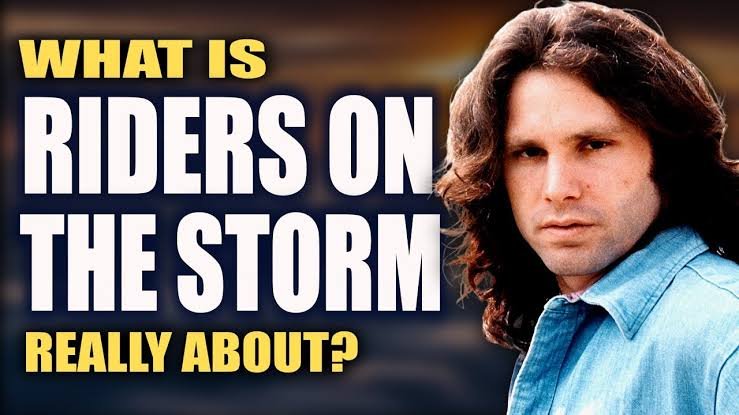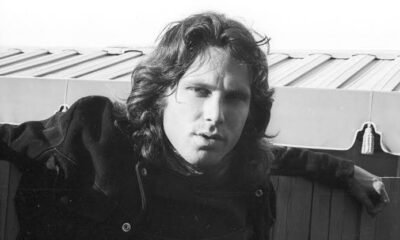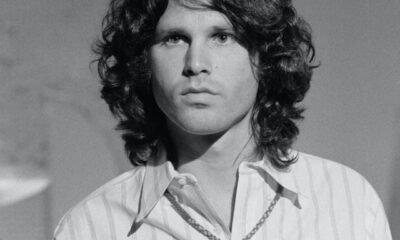Jim Morrison
YOU’LL NEVER HEAR ‘RIDERS ON THE STORM’ THE SAME WAY AGAIN: THE CHILLING TRUE STORY BEHIND THE DOORS’ DARKEST HIT….read more….

YOU’LL NEVER HEAR ‘RIDERS ON THE STORM’ THE SAME WAY AGAIN: THE CHILLING TRUE STORY BEHIND THE DOORS’ DARKEST HIT….read more….
When The Doors released “Riders on the Storm” in 1971, it instantly captured listeners with its haunting melody, whispered vocals, and eerie thunderstorm effects. But few knew then just how dark the inspiration behind the iconic track really was. Today, over five decades later, the song remains a chilling masterpiece — one born from poetry, real-life horror, and the tortured genius of frontman Jim Morrison.
A Rain-Soaked Farewell to an Icon
“Riders on the Storm” was the last song recorded by all four members of The Doors together, and it carries an almost prophetic weight. Morrison, who recorded his whispering backing vocals separately to create a ghostly echo behind his own lead, would be dead just weeks later in Paris at the age of 27. It’s as if the song itself knew the end was near.
Musically, it’s mesmerizing. Ray Manzarek’s jazz-infused electric piano flows like falling rain. Robby Krieger’s guitar crackles like distant lightning. John Densmore’s drums roll in and out like thunder. And Morrison? His voice rides the storm — seductive, dangerous, and unrelenting.
The Birth of a Storm
The song began as a riff off the country classic “(Ghost) Riders in the Sky.” The band was jamming in the studio when Morrison began to recite a poem he had written — dark, moody lines that blurred the line between the spiritual and the sinister. What emerged was “Riders on the Storm,” a song that felt more like a fever dream than a rock single.
But what many don’t know is that Morrison drew part of the song’s chilling narrative from the true story of Billy Cook, a drifter and spree killer who, in the early 1950s, murdered a family of five and a traveling salesman during a deadly cross-country hitchhiking spree.
The lyrics “There’s a killer on the road / His brain is squirmin’ like a toad” are direct nods to Cook, who posed as a stranded hitchhiker to lure victims into his trap. The darkness of this real-world horror bleeds into the song, giving it a level of menace and mystery rarely found in rock music of the time.
Jim Morrison: Poet of the Apocalypse
For Morrison, this was more than a song. It was a reflection of his inner turmoil. Known for his fascination with death, Native American spirituality, and mysticism, Morrison often blurred the line between art and reality. In “Riders on the Storm,” he combines the threat of the external world — the killer on the road — with internal demons.
There’s also a spiritual undertone to the track. Lines like “Into this house we’re born, into this world we’re thrown” hint at existential dread — a sense of being trapped in a chaotic, unpredictable world. Morrison delivers these reflections not with anger, but with eerie detachment, as if he’s already left this world behind.
From Commercial Hit to Cult Classic
Despite its dark themes, “Riders on the Storm” became a commercial success. It charted in the Top 20 in the U.S. and U.K. and has since become one of the most recognized tracks in classic rock history. Its unique blend of jazz, rock, and psychedelia helped define the sound of the early ’70s and earned it a place in the Rock and Roll Hall of Fame’s list of 500 Songs That Shaped Rock and Roll.
Over the years, the song has appeared in films, TV shows, and even commercials — but its true essence remains haunting and surreal. For fans and music historians, it’s more than just a hit. It’s a requiem for Jim Morrison. A storm frozen in time.
Legacy of a Storm
To this day, “Riders on the Storm” continues to fascinate and unsettle. Its mixture of rain-soaked ambiance, poetic depth, and real-life horror create a listening experience that feels immersive and otherworldly. When the thunder claps and the whispered voice of Morrison slides in behind the beat, listeners are transported — not just into a song, but into a cinematic vision of life, death, and danger on the open road.
Jim Morrison may be gone, but “Riders on the Storm” remains — a ghostly echo of a man who saw beauty in darkness and poetry in fear.
So the next time you hear that rolling thunder and the familiar keys of Manzarek’s Rhodes piano, remember: this isn’t just a song. It’s a warning. A whisper from the other side. A ride through the storm that changed rock music forever.

-

 John Force1 month ago
John Force1 month agoJOHN FORCE ANNOUNCES RETIREMENT FROM PROFESSIONAL DRAG RACING AFTER 2025 NHRA SEASON, MARKING END OF ILLUSTRIOUS 45-YEAR CAREER!…..
-

 Susan Hoffs1 week ago
Susan Hoffs1 week agoShe’s Back to Rule the Stage: Susanna Hoffs Unleashes Electrifying 2025 Tour – Here’s Everything You Need to Know….
-

 Robert Fripp1 week ago
Robert Fripp1 week agoStrings of Genius: Netflix Announces Intimate Documentary on Robert Fripp’s Life and Legacy — Release Date Revealed…Details Below….
-

 Imagine Dragon 🐉1 week ago
Imagine Dragon 🐉1 week agoNetflix to Release Imagine Dragons Documentary in 2026: A Deep Dive into the Band’s Meteoric Rise….
-
Erasure1 week ago
Erasure Returns in 2025: Legendary Duo Set to Ignite Global Tour — First Dates Revealed!……
-

 Guyana2 months ago
Guyana2 months agoBreaking News: Putin’s Threat to Bomb Guyana Sparks International Outrage Due to……
-
A-ha1 week ago
A-ha and Morten Harket Announce Surprise 2025 World Tour — Fans Say ‘The Comeback of the Century!…..
-

 The Bangles3 days ago
The Bangles3 days agoThe Bangles Reunite for One Night Only—And It’s Like Time Stood Still….read more…..





